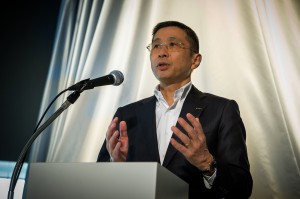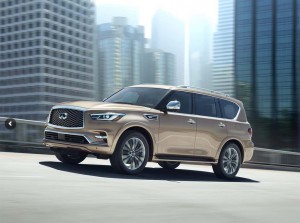
Nissan's Hiroto Saikawa told attendees at the Automotive News World Congress that Infiniti will be electrified by 2021.
Luxury brand Infiniti will rapidly shift away from conventional powertrains and will be “all electrified,” with the exception of some large SUVs by 2021, according to the automaker’s new CEO Hiroto Saikawa.
The auto industry, as a whole is rapidly beginning to electrify as it comes under increasing pressure from regulators around the world. But the plan for Infiniti is one of the most aggressive moves so far announced by any automotive brand with the exception of Volvo which will switch to only hybrid, plug-in or pure battery-electric power for all new models launched by 2018.
“Infiniti will have a specific focus on electrification,” said Saikawa, who replaced Carlos Ghosn as CEO of Nissan Motor Co. on April 1, 2016. “We are trying to position Infiniti as the premier electrified brand” as part of the five-year plan that will extend through 2022.
Until now, Nissan’s luxury arm had actually lagged behind when it comes to using battery drivetrains. Early in the decade it scrubbed a plan to market a more upscale version of the Nissan Leaf battery-electric vehicle, insiders telling TheDetroitBureau.com that it didn’t offer the level of refinement, range or performance that they believed luxury buyers would demand.
(Infiniti Inspired: But what to make of the new Q Inspiration Concept. Click Here for the story.)

The new Infiniti QX80 would be one of the few vehicles Infiniti would not convert to battery-electric power.
Exactly what sort of electrified vehicles Infiniti will now offer is unclear, but pure battery-electric models are all but certainly going to deliver at least 200 miles of range per charge and better acceleration than even the second-generation Leaf.
The plan for Infiniti calls for two types of battery-based models, Saikawa and other sources at Nissan revealed:
- Pure electric vehicles that draw power exclusively from lithium-ion batteries – and potentially next-generation technology, such as solid-state batteries once they are ready for prime time; and
- What the Nissan CEO described at e-Power drivetrains. These also are referred to as extended-range electric vehicles, and include such models as the Chevrolet Volt. While similar to plug-in hybrids, they use onboard gasoline engines solely as generators to power their electric motors.
The electrification process, according to Saikawa, will see Infiniti switch to battery-based drivetrains as new models. “There will be no combustion engines,” except for some large models, likely those like the full-size QX80, his comments would indicate.
The announcement comes as something of a surprise, as the luxury brand appeared to be on a path to depend, at least in part, upon a breakthrough technology known as the Variable Combustion Turbo, or VC-T, engine. When it launches in the months to come it will be the first mass production powertrain that can adjust its compression ratio – anywhere from 8:1 to 14:1 – to yield the best balance between performance, fuel economy and emissions. It appears that new engine will be used in the near term but eventually phased out.
It is unclear if the Nissan brand will continue using it after Infiniti goes electric, or if a version of the variable compression engine might be repurposed as a generator in Nissan and Infiniti e-Power drivetrains.
(Click Here for more about what’s behind the Q Inspiration concept.)
Looking ahead, Saikawa said he was optimistic about the way buyers will accept the move to electric propulsion. “Our assumption for Japan by 2022 is that 40 to 45% of (Infiniti) sales will be electrified and the same for Europe.” By 2025, he added, that would reach 50%.
On the other hand, he saw lower acceptance in the U.S., “maybe 20 to 25%,” noting that Americans drive longer distances and also use larger vehicles that will be slower to switch to battery power.
Saikawa’s comments included another surprise. Asked about the addition of Mitsubishi to the long-running Renault-Nissan Alliance, the executive said his immediate goal is “to demonstrate (having) three (partners) is better than two.” He then added that “If successful, this will open the door to go from three to four.”
(For more on the VD-T engine, Click Here.)
He didn’t mention what other automaker the Euro-Japanese alliance might wish to add, however.
